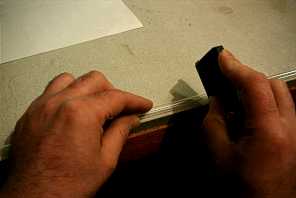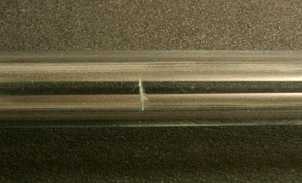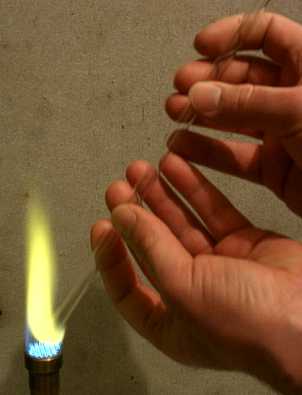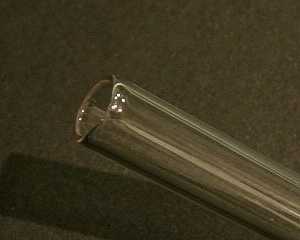 I found that 8mm diameter tube is a good size to practice with. In this example, I take
a half meter length of tube and rest it on the very edge of the work surface. I hold the
tube steady with one hand and take the knife in the other hand.
I found that 8mm diameter tube is a good size to practice with. In this example, I take
a half meter length of tube and rest it on the very edge of the work surface. I hold the
tube steady with one hand and take the knife in the other hand.
| Previous Page | Glass Blowing Menu | Main Menu | Next Page |
|---|
 I found that 8mm diameter tube is a good size to practice with. In this example, I take
a half meter length of tube and rest it on the very edge of the work surface. I hold the
tube steady with one hand and take the knife in the other hand.
I found that 8mm diameter tube is a good size to practice with. In this example, I take
a half meter length of tube and rest it on the very edge of the work surface. I hold the
tube steady with one hand and take the knife in the other hand.
 It is best to run the knife across the tube once. It should not be sawn back and forth.
One sharp scratch is sufficient. The scratch should be 3 to 4mm long and at right angles
to the tube.
It is best to run the knife across the tube once. It should not be sawn back and forth.
One sharp scratch is sufficient. The scratch should be 3 to 4mm long and at right angles
to the tube.
 I grip the tube with both hands, with one thumb either side of the scratch. I hold it with
the scratch and my thumbs facing towards me.
I grip the tube with both hands, with one thumb either side of the scratch. I hold it with
the scratch and my thumbs facing towards me.
 I pull the tube gently length ways as if trying to stretch it and at the same time bend the
ends of the tube away from me and the scratch towards me. I find this is best done as one
swift action. The tube usually severs cleanly with a satisfying click.
I pull the tube gently length ways as if trying to stretch it and at the same time bend the
ends of the tube away from me and the scratch towards me. I find this is best done as one
swift action. The tube usually severs cleanly with a satisfying click.
 The freshly severed end of a tube is sharp and prone to damage. To make it stronger and
safer, it can be rounded over.
The freshly severed end of a tube is sharp and prone to damage. To make it stronger and
safer, it can be rounded over.
The air on the burner should be fully open and the gas turned up to a low to medium sized
flame. The severed end of the tube is then slowly introduced to the base of the flame at
a steep angle so that the end gets the most heat. The tube is then slowly rotated
in the flame. When the glass softens, the flame turns red and then an orangy yellow.
The tube can then be removed from the flame and allowed to cool slowly.
I find that Careful annealing is not normally required after rounding the end of a tube
because it is of uniform thickness and cools evenly. It should not be placed on a cold
surface when it is hot though. It is preferable to place the hot end in the annealing
tin.
 This is the end of the tube after it has been rounded over. It is now stronger and safer
to handle.
This is the end of the tube after it has been rounded over. It is now stronger and safer
to handle.
A more advanced and versatile method of cutting glass tubing is described here.
| Previous Page | Glass Blowing Menu | Main Menu | Next Page |
|---|